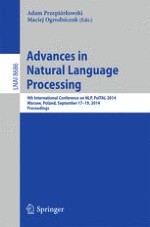This book constitutes the refereed proceedings of the 9th International Conference on Advances in Natural Language Processing, PolTAL 2014, Warsaw, Poland, in September 2014. The 27 revised full papers and 20 revised short papers presented were carefully reviewed and selected from 83 submissions. The papers are organized in topical sections on morphology, named entity recognition, term extraction; lexical semantics; sentence level syntax, semantics, and machine translation; discourse, coreference resolution, automatic summarization, and question answering; text classification, information extraction and information retrieval; and speech processing, language modelling, and spell- and grammar-checking.
